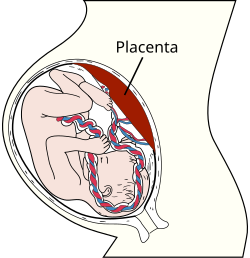Placenta
The placenta is a temporary organ found in eutherian female mammals while they are pregnant.
The placenta is connected to the fetus by the umbilical cord, which is made of blood vessels and connective tissue. When the fetus is delivered, the placenta is delivered afterwards. The placenta is often called the afterbirth.
Function
The placenta protects the mother and fetus
One of the placenta's jobs is to make sure blood from the mother and fetus never mixes. The placenta acts as an exchange surface between the mother and the fetus. Nutrients and oxygen are passed over by diffusion only. If the mother's and fetus's blood mixed, it could be deadly for both of them. If the mother and the fetus had different blood types, they might both die if their blood mixed.
The placental barrier protects the fetus
The placenta has two parts, one of which is genetically and biologically part of the fetus, the other part of the mother. It is implanted in the wall of the uterus, where it receives nutrients and oxygen from the mother's blood and passes out waste. This forms a barrier called the placental barrier, which filters out some substances which could harm the fetus.
However, the placental barrier is not able to protect the fetus from everything that could hurt it. For example, alcohol goes through the placental barrier into the fetus. This is why drinking alcohol during pregnancy can cause Fetal Alcohol Syndrome. The placenta is also unable to filter out many other things. Chemicals that can cross the placental barrier and hurt the fetus are called teratogens.
Some infectious diseases may also cross this barrier and infect the fetus.
In other types of mammals
Prototherial (egg-laying) and metatherial (marsupial) mammals produce a type of placenta that provides nutrients mostly from the egg sac, instead of from the mother's blood. It is positioned in the female's body similar to eutherian mammals. Some snakes and lizards have evolved a system of internal development with a placenta-like tissue: this is an example of convergent evolution.[1]
References
- ↑ Pough et al 2002. Herpetology. 3rd ed, Pearson Prentice Hall.

